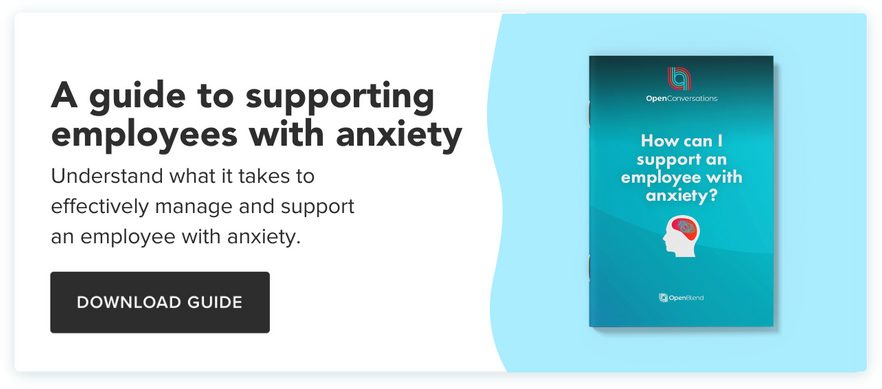Supporting an employee who has anxiety really comes down to understanding how their condition affects them. The approach you take to managing and supporting an employee with anxiety should, in essence, be no different from managing any other employee: it’s about making sure one-to-one conversations are inclusive and provide a safe space for the right conversations to occur.
When you account for an individual's unique circumstances, their symptoms, experiences and triggers with anxiety you'll equip yourself with the right information and methods to address them. A one-size-fits-all approach simply won't work.
Everyone has different circumstances, personalities, priorities, and challenges: someone with anxiety will just have different motivators and obstacles to someone who doesn’t. What is important is making reasonable adjustments to support their anxiety, especially (but not only) if it is a diagnosed condition under the Equality Act. Someone with social anxiety disorder, for instance, may be unable to attend a client's social function because of their disorder, not because they don’t feel like it or are not committed to their role. The key to understanding and making those adjustments? Yes, you guessed it – one-to-one conversation.
6 tips to supporting an employee with anxiety
Below are 6 key tips for managing employees with anxiety effectively. These tips can be used to support your management techniques right from the get-go.
Remember, every employee is different: whether they have an anxiety condition or not.
These tips all come with a caveat: ask the right questions before you assume anything about the individual or their condition.
1) Ask the right question, to best understand their needs and challenges
Make sure you ask the right questions and steer well clear of making any assumptions. It's hard to understand how anxiety manifests itself if you haven't experienced its symptoms first-hand, and even then, anxiety symptoms that stem solely from work-related stress issues are very different from anxiety triggered by social settings. Find out what the individual needs to manage their role, rather than making sweeping generalisations about where their anxiety stems from, and its causes. Take time to really listen, regular one-to-ones are essential to this, as their needs and challenges can change over time - or as their role develops.
2) Keep a close eye on their confidence and ability to manage stress
Anxiety is not just a feeling of worry: it can have a range of symptoms, some of which can even present as physical ailments. Giving an employee with anxiety a way to keep track of their confidence and their ability to manage stress is essential. It can help you both to pinpoint triggers that are worsening their condition and tackle them before they get out of hand.
3) Proactively monitor wellbeing
Addressing wellbeing has to go beyond a quick ‘how are you?’ By giving every employee a way to measure their wellbeing and keep track of changes, anxiety sufferers will feel more empowered to flag when their wellbeing is being affected.
4) Address how you give feedback
One mistake that managers make is to stop having difficult conversations once an employee discloses their anxiety. For the report, this can trigger even more anxiety and hinder their progression and fulfilment at work. Instead, look at how you give feedback, making it prescriptive, achievable and aligned with clear goals. Don’t forget to share recognition for successes, too.
5) Allow for preparation
Being blindsided by an unexpected task or conversation can worsen anxiety, particularly when it comes to one-to-one meetings. Allowing the employee to see meeting agendas ahead of time and set their own agenda, will enable more effective and relaxed conversations and create a safe space where they can
By scheduling regular 1:1s, asking the right questions, listening, and taking action, you can help reports with anxiety to manage their condition and perform to the best of their ability at work. By building coaching techniques into one-to-one meetings, you can help employees to identify triggers, overcome challenges and continue to progress at work.

If you want a better way to manage and coach employees with anxiety effectively, book a discovery call with OpenBlend today. We’ll provide you with unique insight into how the right conversations, at the right time, make for more effective one-to-ones.